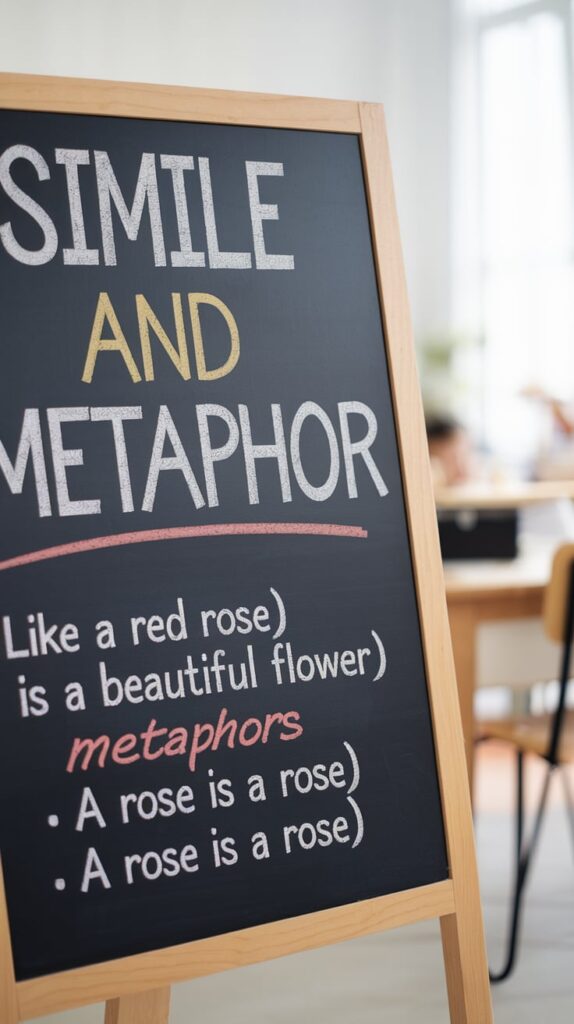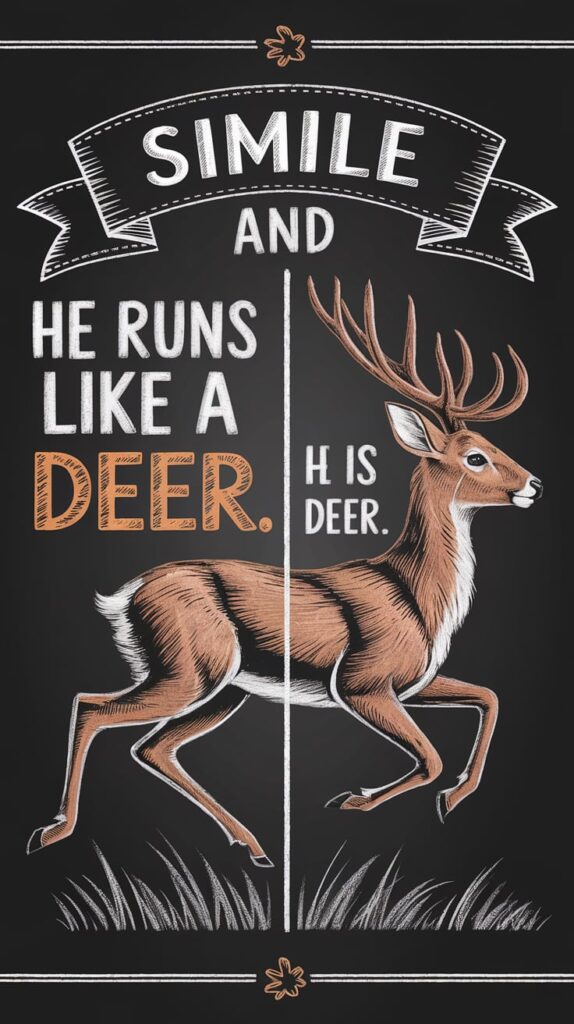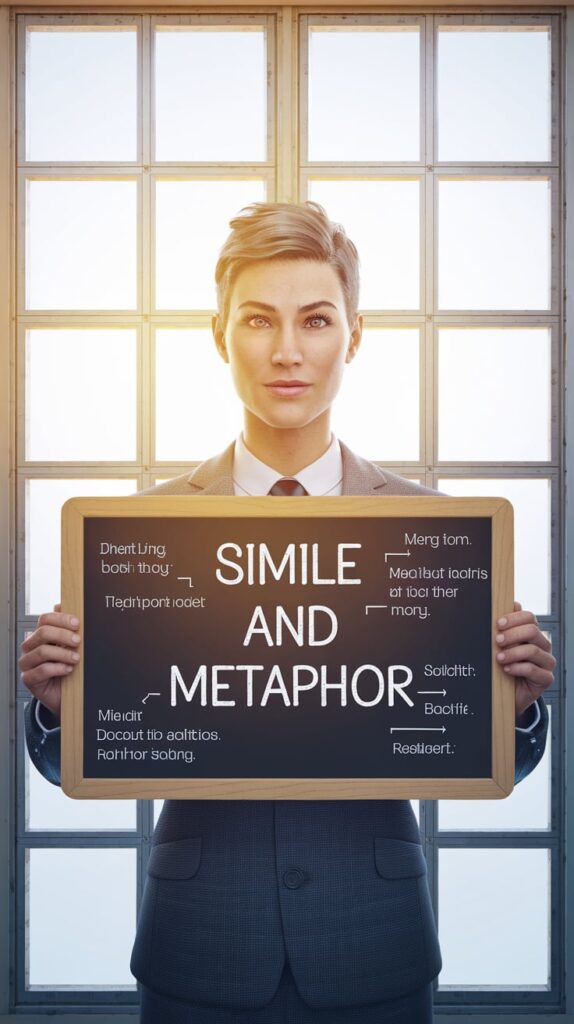Similes and metaphors enhances our communication, creating vivid imagery and connecting complex ideas in engaging ways. Among the most effective tools in this realm are similes and metaphors.
While both serve the purpose of making comparisons, they do so differently. This article explores the nuances between similes and metaphors, their structures, uses, and the profound impact they have on our language.
read more : Thomas’s or Thomas’ – Grammar Beacon

What is a Simile?
A simile is a figure of speech that directly compares two unlike things, using “like” or “as.” This comparison helps create clarity and vivid imagery, making abstract concepts easier to grasp.
How Similes are Structured
Similes generally follow a simple structure:
- Format: [Subject] + “like” or “as” + [Comparison]
For example:
- “Her smile is like sunshine.”
- “He is as brave as a lion.”
These comparisons allow readers to visualize and understand the qualities being highlighted, making similes a powerful tool in both everyday language and creative writing.
When to Avoid Similes
While similes can enhance writing, overusing them can diminish their impact. Here are situations where you might want to avoid similes:
- Clichés: Expressions like “as busy as a bee” have become tired and can make your writing feel unoriginal.
- Excessive Detail: In technical or formal writing, similes might distract from the main point.
- Unnecessary Comparisons: If the imagery doesn’t enhance understanding or enjoyment, it might be better to omit it.
By knowing when to avoid similes, you can use them more effectively, ensuring that your writing remains fresh and engaging.
read more : Plural of Foreman – Grammar Beacon

What is a Metaphor?
A metaphor is another figure of speech that implies a comparison without using “like” or “as.” By stating that one thing is another, metaphors create deeper associations and evoke emotions more powerfully.
How Metaphors are Structured
Metaphors typically follow this structure:
- Format: [Subject] + “is” or “are” + [Comparison]
For instance:
- “Time is a thief.”
- “Her heart is a cold iron.”
These statements invite readers to explore the underlying meanings and associations, often leading to a more profound interpretation.
Types of Metaphors
Understanding the different types of metaphors can enhance your writing. Here’s a breakdown of the various types:
Simple Metaphor
A simple metaphor compares two unlike things directly. For example, “Life is a journey.” This straightforward comparison helps convey complex ideas in an easily digestible manner.
Extended Metaphor
An extended metaphor develops a comparison over several sentences or lines, exploring it in depth. For example, Shakespeare’s “All the world’s a stage” elaborates on the roles people play in life, adding layers of meaning.
Implied Metaphor
An implied metaphor suggests a comparison through context without directly stating it. For example, “The sun danced on the horizon” implies brightness and warmth without explicitly mentioning these qualities.
Dead Metaphor
A dead metaphor refers to common phrases that have lost their original impact. For example, “The leg of the table” is a metaphor that many use without thinking of its figurative roots.
read more : Arised or Arose: What’s the Correct Past Tense of Arise? – Grammar Beacon
Similarities Between Simile and Metaphor
Both similes and metaphors share common ground:
- Imagery: They create vivid pictures in the reader’s mind, enhancing the reading experience.
- Emotional Impact: Both can evoke strong feelings and connections, making them powerful tools for writers.
- Literary Devices: They enhance writing by providing clarity and depth, allowing authors to express complex ideas succinctly.
By recognizing these similarities, writers can harness the power of both devices to enrich their storytelling.

Differences Between Simile and Metaphor
While similes and metaphors share similarities, they differ significantly:
- Word Usage: Similes use “like” or “as,” whereas metaphors make direct comparisons.
- Impact Level: Metaphors tend to be more thought-provoking and layered, while similes are often more straightforward and relatable.
- Clarity vs. Complexity: Similes can be more accessible, while metaphors require deeper interpretation.
| Feature | Simile | Metaphor |
| Comparison Type | Uses “like” or “as” | Direct comparison |
| Emotional Depth | More relatable | Often deeper and more complex |
| Usage in Writing | Easier to understand | Evokes profound interpretations |
Understanding these differences allows writers to choose the most effective device for their intended message.
read more : Plural of Syllabus? – Grammar Beacon
Simile vs. Metaphor Examples
To illustrate these differences, here are some examples of similes and metaphors:
Simile Examples
- “Her eyes sparkled like diamonds.”
- “The wind howled like a pack of wolves.”
- “He swims like a fish.”
- “She danced like a leaf in the wind.”
- “He was as strong as an ox.”
Metaphor Examples
- “The classroom was a zoo.”
- “Her laughter was music to my ears.”
- “He is the black sheep of the family.”
- “The world is a stage.”
- “The night sky is a blanket of stars.”
These examples showcase how both similes and metaphors can convey complex ideas and emotions, enhancing the reader’s experience.
FAQs about Similes and Metaphors
Can a simile become a metaphor?
Absolutely! You can transform a simile into a metaphor by removing “like” or “as.” For example, changing “She is like a rose” to “She is a rose” shifts it from a simile to a metaphor.
Are similes or metaphors more effective?
Both serve their purpose well, depending on context. Similes may be more accessible for readers, while metaphors can provoke thought and deeper understanding.
read more : What Does Compare and Contrast Mean? – Grammar Beacon

Can they be used together?
Yes! Using similes and metaphors together can create rich, layered descriptions. Just remember to use them sparingly to avoid overwhelming your audience. A balanced approach enhances the overall effectiveness of your writing.
Practical Applications of Similes and Metaphors
Understanding similes and metaphors is not just an academic exercise; it has practical applications in various fields, including:
Creative Writing
In creative writing, similes and metaphors can enhance storytelling by adding depth and emotion. They help paint vivid pictures that draw readers into the narrative.
Example: “Her heart is a fragile glass ornament, beautiful but easily shattered.”

Poetry
Poets often rely heavily on similes and metaphors to convey complex emotions and imagery succinctly. These devices allow poets to express abstract ideas in tangible ways.
Example: “Time is a river, flowing endlessly.”
Public Speaking
Effective public speakers use similes and metaphors to clarify their points and engage their audience. By illustrating their ideas, they make complex topics more relatable and memorable.
Example: “Navigating through life’s challenges is like sailing through a storm; it requires skill and perseverance.”
Advertising
In advertising, similes and metaphors can make products more appealing by creating emotional connections. Marketers often use these devices to craft memorable slogans and taglines.
Example: “Our coffee is a warm hug on a cold morning.”
The Role of Similes and Metaphors in Emotional Response
Similes and metaphors play a significant role in evoking emotional responses from readers. By creating relatable and vivid comparisons, these devices can tap into our feelings and experiences.
Building Connections
Both similes and metaphors foster connections between the writer and the reader. They allow authors to express emotions and ideas that resonate on a personal level.
Enhancing Understanding
Metaphors, in particular, can clarify complex emotions or concepts by relating them to something familiar. This technique can make difficult subjects more accessible.
Encouraging Reflection
Metaphors often invite readers to reflect on deeper meanings and implications, prompting them to consider their own experiences and interpretations.
Creative Exercises to Master Similes and Metaphors
Practicing similes and metaphors can improve your writing skills significantly. Here are some creative exercises to help you master these figurative language tools:
Simile Writing Prompts
- Describe a sunset using a simile.
- Compare a friend’s laughter to something unexpected.
- Write a simile about your favorite season.
- Compare the sound of rain to a musical instrument.
Metaphor Writing Prompts
- Write a metaphor that describes your life right now.
- Create a metaphor for a challenging situation you’ve faced.
- Describe love using a metaphor.
- Write a metaphor about time.
Combining Similes and Metaphors
Challenge yourself to write a short paragraph that includes both similes and metaphors. This exercise will help you practice balancing the two devices while enhancing your descriptive skills.
The Impact of Cultural Context on Similes and Metaphors
Cultural context plays a significant role in how similes and metaphors are understood. Different cultures have unique expressions and imagery that can lead to varied interpretations.
Cultural Variations in Similes
Similes may differ greatly across cultures. For instance, an expression that is common in one culture may be completely unfamiliar in another, leading to confusion.
Example: “As strong as an ox” may not resonate in cultures where oxen are not part of daily life.

Metaphors and Cultural Significance
Metaphors often carry cultural significance, reflecting values and beliefs. Understanding the cultural context can deepen comprehension and appreciation of figurative language.
Example: In some cultures, the metaphor “
The world is a stage” may resonate strongly, highlighting the performance aspect of life, while in others, it may not have the same impact.
Conclusion
Understanding similes and metaphors unlocks the power of figurative language, allowing you to convey complex ideas and emotions with ease. By mastering these tools, you enhance your communication skills, making your writing more engaging and impactful.
Whether you opt for a straightforward simile or a thought-provoking metaphor, both will enrich your expression, bringing your words to life. Embrace the art of comparison, and watch your writing flourish!
In the end, the effective use of similes and metaphors not only improves your writing but also fosters a deeper connection with your audience.
So, the next time you write, consider how you can incorporate these powerful figurative language devices to connect with your readers on a deeper level. The journey of mastering similes and metaphors will undoubtedly enhance your writing and leave a lasting impression.

James Logan is a seasoned blogger and language enthusiast behind Grammar Beacon. With years of experience in grammar and writing, James shares his expertise through insightful and engaging content. His passion for clear communication and linguistic precision shines in every post, making complex grammar concepts accessible and enjoyable for readers. Follow James for expert advice and tips to refine your writing skills.







